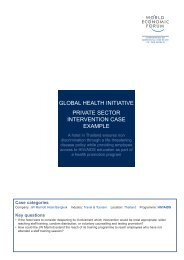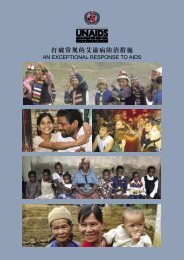X HIV/AIDS Prevention and Care in Resource-Constrained Settings
X HIV/AIDS Prevention and Care in Resource-Constrained Settings
X HIV/AIDS Prevention and Care in Resource-Constrained Settings
- No tags were found...
Create successful ePaper yourself
Turn your PDF publications into a flip-book with our unique Google optimized e-Paper software.
R EDUCING MOTHER-TO-CHILDTRANSMISSIONThe number of <strong>in</strong>fants <strong>in</strong>fected with <strong>HIV</strong> eachyear through mother-to-child transmission (MTCT) isgrow<strong>in</strong>g with the <strong>in</strong>creas<strong>in</strong>g number of women<strong>in</strong>fected with <strong>HIV</strong>. About 55 percent of all new <strong>HIV</strong><strong>in</strong>fections <strong>in</strong> Africa occur among women, most ofwhom are <strong>in</strong> their childbear<strong>in</strong>g years. Ten percent of<strong>in</strong>fections—represent<strong>in</strong>g some half a million <strong>in</strong>fants—are believed to be attributable to MTCT.The 1998 f<strong>in</strong>d<strong>in</strong>gs from the Thai Short CourseZidovud<strong>in</strong>e (AZT) Regimen study <strong>in</strong> Thail<strong>and</strong>, <strong>and</strong>1999 f<strong>in</strong>d<strong>in</strong>gs from the Nevirapene Field Trial <strong>in</strong>Ug<strong>and</strong>a, demonstrated that even simple, relatively<strong>in</strong>expensive ARV regimens can substantially reduceMTCT. Recogniz<strong>in</strong>g that comprehensive <strong>in</strong>terventionscan reduce MTCT rates by as much as half, we nowhave the tools to exp<strong>and</strong> MTCT prevention programs,especially <strong>in</strong> those countries with high <strong>HIV</strong> prevalence.These programs must set st<strong>and</strong>ards; promotevoluntary counsel<strong>in</strong>g <strong>and</strong> test<strong>in</strong>g (VCT); providetra<strong>in</strong><strong>in</strong>g to health care workers; establish l<strong>in</strong>kages tocommunity-based care services; <strong>and</strong> scale-up primaryprevention for all women.C ARE AND TREATMENTBasic <strong>HIV</strong> care services are m<strong>in</strong>imal <strong>in</strong> manyresource-constra<strong>in</strong>ed countries. Few <strong>in</strong>fected personsknow their <strong>HIV</strong> status; most health care workers lackthe tra<strong>in</strong><strong>in</strong>g to treat <strong>HIV</strong> <strong>and</strong> its associated <strong>in</strong>fections;<strong>and</strong> only a few sett<strong>in</strong>gs have the capacity to use stateof-the-artARVs, which rema<strong>in</strong> unavailable to themajority of those <strong>in</strong>fected.Even without ARVs, much can be done to improvethe well-be<strong>in</strong>g of <strong>HIV</strong>-<strong>in</strong>fected persons <strong>and</strong> theirfamilies. Foremost must be assur<strong>in</strong>g access to a basicpackage of care that <strong>in</strong>cludes treatment of TB, treatment<strong>and</strong> prevention of other opportunistic <strong>and</strong> <strong>AIDS</strong>relatedillnesses <strong>and</strong> palliative care to reduce suffer<strong>in</strong>g<strong>and</strong> enhance the quality of life. To achieve this goal,networks will have to be established to connect hospital,cl<strong>in</strong>ic, faith-based <strong>and</strong> community-based services.There must be an <strong>in</strong>vestment <strong>in</strong> exp<strong>and</strong><strong>in</strong>g effectiveTB prevention <strong>and</strong> control programs <strong>in</strong> key countries.TB is a grow<strong>in</strong>g epidemic itself with two milliondeaths per year worldwide. Because it is the lead<strong>in</strong>gcause of death for people with <strong>AIDS</strong>, efforts to prevent<strong>and</strong> treat TB must receive special attention.There is <strong>in</strong>creas<strong>in</strong>g <strong>in</strong>terest <strong>in</strong> the develop<strong>in</strong>g world<strong>in</strong> the use of comb<strong>in</strong>ation regimens of ARVs, whichcan prolong the lives of PLHA. It is <strong>in</strong>evitable thatthe cost of these drugs will decrease. Even now, localproduction of generic drug equivalents <strong>and</strong> recent pricereductions by the pharmaceutical companies havelowered the annual cost for a comb<strong>in</strong>ation of ARVs toapproximately US$1500 per patient. But it is criticalto grasp the complexity of provid<strong>in</strong>g ARV therapy <strong>in</strong> adevelop<strong>in</strong>g country sett<strong>in</strong>g. An effective ARV programrequires, at a m<strong>in</strong>imum, four basic components:1. A susta<strong>in</strong>able supply of drugs: This is life-longtreatment <strong>and</strong> improper use will result <strong>in</strong> drugresistance.2. The capacity to use the drugs: Most Africancountries lack the necessary tra<strong>in</strong>ed health careworkers, labs, drug management systems, etc. It isimportant to remember that the health <strong>in</strong>frastructure<strong>in</strong> many of the hardest hit countries is on theverge of collapse. Such basic services as childhoodimmunization rates are often less than 50 percent(Ug<strong>and</strong>a), the number of attended births is only33 percent (Nigeria) <strong>and</strong> the number of tra<strong>in</strong>edphysicians can amount to only one for every13,000 persons (Zambia).3. An equitable system to apportion treatment <strong>in</strong>sett<strong>in</strong>gs where there is not enough to go around.4. Recognition that treatment of <strong>HIV</strong> does not preventnew <strong>in</strong>fections <strong>and</strong> cannot replace soundprevention programs. As ARVs become less costly<strong>and</strong> the regimens simpler, <strong>HIV</strong>/<strong>AIDS</strong> efforts must<strong>in</strong>corporate ARVs as critical components of theirprograms.XXII <strong>HIV</strong>/<strong>AIDS</strong> <strong>Prevention</strong> <strong>and</strong> <strong>Care</strong> <strong>in</strong> <strong>Resource</strong>-Constra<strong>in</strong>ed Sett<strong>in</strong>gs
















